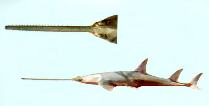http://www.fishbase.org/Summary/speciesSummary.php?genusname=Anoxypristis&speciesname=cuspidata ---> http://52.67.158.155/Summary/speciesSummary.php?genusname=Anoxypristis&speciesname=cuspidata
http://52.67.158.155/Summary/speciesSummary.php?genusname=Anoxypristis&speciesname=cuspidata ---> https://fishbase.net.br/Summary/speciesSummary.php?genusname=Anoxypristis&speciesname=cuspidata
https://fishbase.net.br/Summary/speciesSummary.php?genusname=Anoxypristis&speciesname=cuspidata ---> https://fishbase.net.br/summary/Anoxypristis-cuspidata.html
Anoxypristis cuspidata, Pointed sawfish : fisheries, gamefish

You can
sponsor
this page
Common name (e.g. trout)
Genus + Species (e.g. Gadus morhua)
-

-
About this page
-
Languages
-
User feedbacks
-
Citation
-
Uploads
-
Related species
-


 Pointed sawfish
Add your observation in
Fish Watcher
Upload your
photos
and
videos
Pointed sawfish
Add your observation in
Fish Watcher
Upload your
photos
and
videos
Pictures
|
Google image
 Anoxypristis cuspidata
Anoxypristis cuspidata
Picture by
CSIRO
Elasmobranchii (sharks and rays) >
Rhinopristiformes
(Shovelnose rays) >
Pristidae
(Sawfishes)
Etymology:
Anoxypristis:
Greek, ana = up + Greek, oxy = sharp, pointed + Greek, pristis = saw (Ref.
45335
)
.
Environment: milieu / climate zone / depth range / distribution range
Ecology
Marine; freshwater; brackish; benthopelagic; amphidromous (Ref.
51243
); depth range 0 - 40 m (Ref.
9859
), usually ? - 40 m (Ref.
55270
). Tropical; 43°N - 20°S, 30°E - 160°E (Ref.
114953
)
Indo-West Pacific: widespread, Red Sea to eastern Australia, north to Japan.
Length at first maturity / Size / Weight / Age
Maturity: L
m
264.0
, range 246 - 282 cm
Max length : 470 cm TL male/unsexed; (Ref.
9859
)
Greyish above, pale below; fins usually pale. Body shark-like, pectoral fins distinct; head flattened, with a blade-like snout bearing 18-22 pairs of lateral teeth; blade slender, not tapering distally. Nostrils very narrow with small nasal flaps. Rostral teeth short, flattened, broadly triangular, lacking a groove along posterior margins; no teeth on basal quarter of blade. Adults with widely spaced denticles, young with naked skin.
Found inshore, often in river deltas and estuaries; penetration well up rivers needs confirmation (Ref.
9859
). Common in sheltered bays with sandy bottoms. More active swimmer than other sawfishes (Ref.
114953
). Feeds on small fish, cuttlefish (Ref.
9859
) and small benthic invertebrates such as prawns (Ref.
114953
). Ovoviviparous (Ref.
50449
). Most fecund sawfish, reported to reach sexual maturity at 2-3 years (Ref.
114953
). Females have litters of approximately 12 pups (Ref.
114953
). Generally harmless but its saw-like snout may cause serious injury when caught: it is known thrash violently and vigorously (Ref.
9859
). Caught for its flesh and liver (which is rich in oil) in some parts of Asia (Ref.
6871
). Maximum lengths of up to 610 cm TL are based on unconfirmed reports (Ref.
9859
).
Life cycle and mating behavior
Maturity
|
Reproduction
|
Spawning
|
Eggs
|
Fecundity
|
Larvae
Ovoviviparous. Litter size from 6 to 23, young born in the spring (Ref.
9859
).
Mould, B.
, 1994. A world list of rays. The scientific nomenclature and distribution of the recent Batoidea (Batoidea, Elasmobranchii, Chondrichthyes). University of Nottingham, [UK]. 82 p. (Ref.
8630
)
IUCN Red List Status (Ref.
130435
)
Critically Endangered (CR)
(A2cd); Date assessed:
29 March 2022
CITES
Appendix I:
International trade banned
Appendix I & II:
Endangered migratory species conserved through agreements
Threat to humans
Harmless (Ref.
9859
)
Human uses
Fisheries: commercial; gamefish: yes
FAO - Publication:
search
|
FishSource
|
More information
Countries
FAO areas
Ecosystems
Occurrences
Introductions
Stocks
Ecology
Diet
Food items
Food consumption
Ration
Common names
Synonyms
Metabolism
Predators
Ecotoxicology
Reproduction
Maturity
Spawning
Spawning aggregation
Fecundity
Eggs
Egg development
Age/Size
Growth
Length-weight
Length-length
Length-frequencies
Morphometrics
Morphology
Larvae
Larval dynamics
Recruitment
Abundance
BRUVS
References
Aquaculture
Aquaculture profile
Strains
Genetics
Electrophoreses
Heritability
Diseases
Processing
Nutrients
Mass conversion
Collaborators
Pictures
Stamps, Coins Misc.
Sounds
Ciguatera
Speed
Swim. type
Gill area
Otoliths
Brains
Vision
Tools
E-book
|
Field guide
|
Identification keys
|
Length-frequency wizard
|
Life-history tool
|
Point map
|
Classification Tree
|
Catch-MSY
|
Special reports
Check for Aquarium maintenance
|
Check for Species Fact Sheets
|
Check for Aquaculture Fact Sheets
Download XML
Summary page
|
Point data
|
Common names
|
Photos
Internet sources
AFORO (otoliths) |
Aquatic Commons
|
BHL
|
Cloffa
|
BOLDSystems
|
Websites from users
|
Check FishWatcher
|
CISTI
|
Catalog of Fishes
:
genus
,
species
|
DiscoverLife
|
ECOTOX
| FAO - Publication:
search
|
Faunafri
| Fishipedia |
Fishtrace
| GenBank:
genome
,
nucleotide
|
GloBI
|
Google Books
|
Google Scholar
|
Google
| IGFA World Record |
MitoFish
|
National databases
|
Otolith Atlas of Taiwan Fishes
|
PubMed
| Reef Life Survey | Socotra Atlas |
Tree of Life
| Wikipedia:
Go
,
Search
| World Records Freshwater Fishing |
Zoological Record
Estimates based on models
Preferred temperature (Ref.
123201
): 24.6 - 29.1, mean 28.2 °C (based on 1982 cells).
Phylogenetic diversity index (Ref.
82804
): PD
50
= 1.0078 [Uniqueness, from 0.5 = low to 2.0 = high].
Bayesian length-weight: a=0.00501 (0.00198 - 0.01270), b=3.05 (2.83 - 3.27), in cm total length, based on LWR estimates for this (Sub)family-body shape (Ref.
93245
).
Trophic level (Ref.
69278
): 4.5 ±0.62 se; based on food items.
Resilience (Ref.
120179
): Low, minimum population doubling time 4.5 - 14 years (Fec assumed to be <100).
Fishing Vulnerability (Ref.
59153
): Very high vulnerability (90 of 100).
Price category (Ref.
80766
):
Medium
.
Back to Search
Random Species
Back to Top
Accessed through:
Not available
FishBase mirror site :
Laguna, Philippines
Page last modified by :
mrius-barile
|